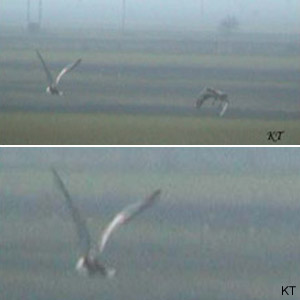Magazine | Analyses
Observation de trois Grandes Outardes en Grèce

Grandes Outardes (Otis tarda), Aghioi Anargyroi, Thessalie, Grèce, mars 2005.Photographies : Êyriakos Tsipis
Introduction
Au début dumois de mars 2005, un professeur de lycée a observé trois Grandes Outardes (Otis tarda) dans un champ près d’Aghioi Anargyroi, dans la plaine de Thessalie (département de Larissa), au centre de la Grèce, et il a et tranmis l’information à l’HOS (Hellenic Ornithological Society). Michel Moschovis, un adhérent de de la HOS, est ensuite allé sur place pour confirmer cette donnée exceptionnelle : en effet, l’espèce a disparu de la région il y a plus plus de 30 ans, du fait de l´intensification de l´agriculture et de la chasse illégale.
Êyriakos Tsipis, un ami de Michel Moschovis, y est retourné les 26 et 27 mars et il a fait quelques clichés des oiseaux, que nous vous présentons ici. Cet article sera l’occasion d’évoquer les hypothèses possibles de la présence de ces oiseaux loin de leurs zones de reproduction.
Abstract
The Great Bustard (Otis tarda) is a large bird (wingspan : 190-260 cm, up to 18 kg) living in grasslands , agricultural habitats and pastures throughout its European range. It is globally threatened, classified as Vulnerable and is included in Annex I of the EU Wild Birds Directive. The European population is estimated to be between 23,790 and 30,483 individuals (data gathered at the 1994 workshop) but there has been a rapid decline in much of central and eastern Europe, due to the intensification of agricultural habitats and illegal hunting. The Great Bustard has gone extinct in Denmark, France, Sweden and Britain and Greece. In this last country, the last breeding has been recorded around the 1930’s, in the Thessalie Region.
In March 2005, 3 birds have been watched in a field near Aghioi Anargyroi, in the Larissa district. Michel Moschovis, member of the HOS (Hellenic Ornithological Society), and a friend of him, Êyriakos Tsipis, watched the birds and photographied them.
Poursuivez la lecture de cet article, en vous abonnant dès maintenant !
Découvrez les Archives d’Ornithomedia.com
Pour seulement 10,00 €TTC/an (ou 6,00 € les 6 mois)
Profitez de plusieurs centaines d’articles en accès illimité et sans aucun engagement.
Compléments
À lire aussi sur Ornithomedia.com
- Ces Grandes Outardes anglaises qui traversent la Manche
- Massacre de Grandes Outardes en Syrie
- Observer la Grande Outarde en Grande-Bretagne
- De l’outarde à l’olivier
- Observer les oiseaux dans les plaines de Villafáfila
- Voyage ornithologique dans le nord de la Grèce du 22 avril au 20 mai 2009
- Séjour ornithologique en Grèce du 16 au 25 avril 2004 : première partie
Les observations sur Ornithomedia.com
Source
RSPB. Conservation of the Northern Bald Ibis in Syria and the Middle East. www.wwww.rspb.org.uk/whatwedo/projects/details/220817-conservation-of-the-northern-bald-ibis-in-syria-and-the-middle-east
Gianluca Serra et al (2011). Breeding range of the last eastern colony of Critically Endangered Northern Bald Ibis Geronticus eremita in the Syrian steppe: a threatened area. Bird Conservation International. Pages 1 à 12. www.gianlucaserra.com




Aucun commentaire sur ce sujet
Participer à la discussion !